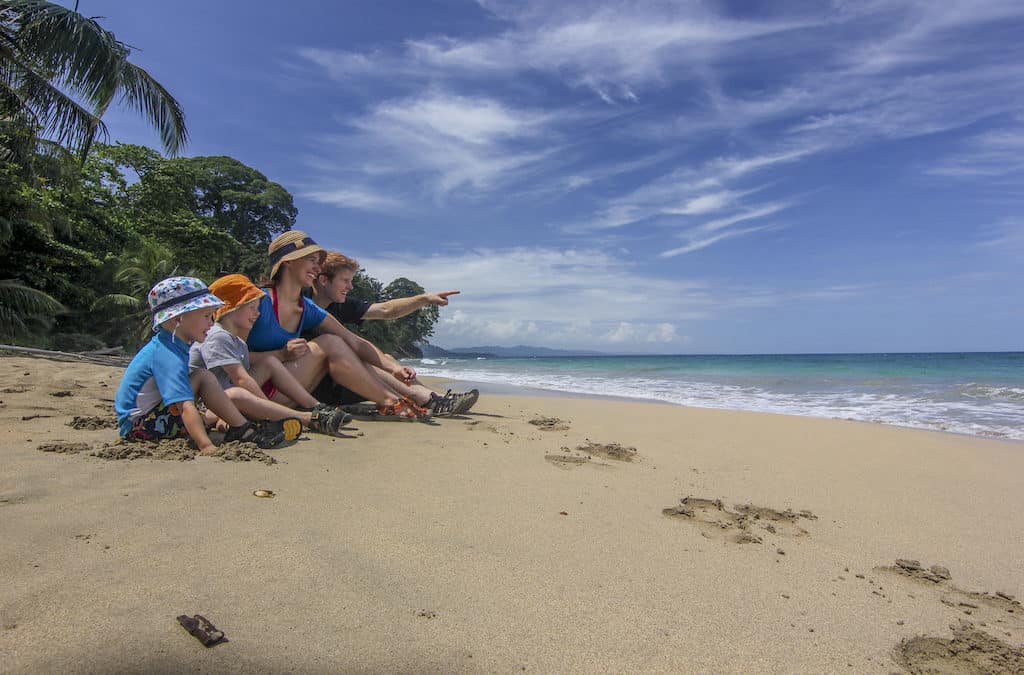To ensure that you have the best possible getaway in Costa Rica, follow these safety and wellness tips. A few precautions, avoidances, and small efforts can make the difference between a positively memorable vacation in Costa Rica and a would-like-to forget one.
Wear Sunscreen
ALWAYS. Trying to get a base tan the first day basically means that you will be crispy for the rest of your vacation. The sun in Costa Rica is extremely strong, whether it is a cloudless or cloudy day. While a sunburn never feels good, having a sunburn while in a hot tropical environment is next level discomfort. Avoid a painful burn, a nasty peel, and pre-mature signs of aging by coating up every time before you walk out into the sun.
To help protect the coral reefs and ocean environment, please avoid using sunscreens that contain oxybenzone and octinoxate. Hawaii has already banned these two ingredients because they are greatly contributing to the death of our coral reefs and are actually proving to be harmful to us as well. Stay tuned next week for a guide to ocean-friendly sunscreens and products to bring, buy, and use in Costa Rica.

Apply bug spray
There are mosquitos all year around in Costa Rica and unfortunately, some of those mosquitos carry dangerous viruses like dengue, chikungunya, and zika. There are quite a few natural mosquito repellents that are made in Costa Rica (check out the RipJack Inn gift shop) that work really well. Whatever brand or type you decide to use, use it liberally while in Costa Rica.
Stay hydrated
Between the heat, humidity, and likelihood that you will be engaging in some active activities, it is crucial that you drink enough water throughout the day. Dehydration and heat exhaustion will definitely put a damper on your fun level. You should be drinking at the very least two liters of water a day, but more if you are surfing or doing any other type of physical activity. Bring or buy a reuseable water bottle to fill up while in Costa Rica to help reduce single-use plastic waste.
A delicious and hydrating treat that you should definitely indulge in daily is an iced cold pipa (a fresh coconut). Coconut water is chalked full of electrolytes and potassium, which are key for hydration and energy. You can often spot a guy walking on the beach or close to it with a cooler filled with them.

Know about rip currents
A rip current is a very strong and often narrow current that can rip an unsuspecting ocean-goer right out to sea in the blink of an eye. Playa Grande, among many other beaches in Costa Rica and around the world are susceptible to these dangerous currents. However, if you follow these tips, you will be fine.
- Don’t panic.
- Don’t try and fight the current by swimming against it.
- Because rip currents are often narrow and don’t typically go that far out, the best approach is to either try and exit the current by swimming parallel to it or let it take you out, and once it eases up then turn and swim diagonally back to shore.
- If you are not a strong swimmer, call for help and float on your back to conserve energy.
- When you look out at the ocean, you can usually tell where these currents are. It is important to be aware and alert anytime that you go into the ocean.

Don’t swim in rivers
Taking a guided river boat tour up the Playa Grande estuary or down the Tempisque river is an extraordinary and wildlife-rich nature tour. You’ll definitely see a lot of crocodiles. The key here is to observe the creatures of the river from a boat. Costa Rica is home to a very large population of crocodiles and the rivers and river mouths are their territory. Bull sharks also really love river mouths for their murky and food dense waters. While incidences are very rare, it is just a safer call to avoid swimming in the rivers and instead opt to cool off in the sea or swimming pool.

Protect your valuables
While Costa Rica is a relatively safe country, one thing that is quite common is petty theft. Do not leave anything out that could possibly tempt a thief to break into your car or home base. Don’t leave anything unattended on the beach that you would be devastated if it was not there when you returned. Don’t leave your house unlocked and lock up your passports and highly valuable items in a safe. As long as you take the time to secure your belongings, you should have no issues.
Drive slowly
Slow down. The streets of Costa Rica are often only two lane, dotted with pot holes, slicked with loose gravel, lacking guard rails, and shared with iguanas, birds, snakes, crabs, sloths, monkeys, cows, horses, goats, dogs, cats, pedestrians, and children. You are on vacation, slow down, and just arrive when you arrive. And while you are driving slowly, enjoy the exquisite scenery and roadside wildlife.

